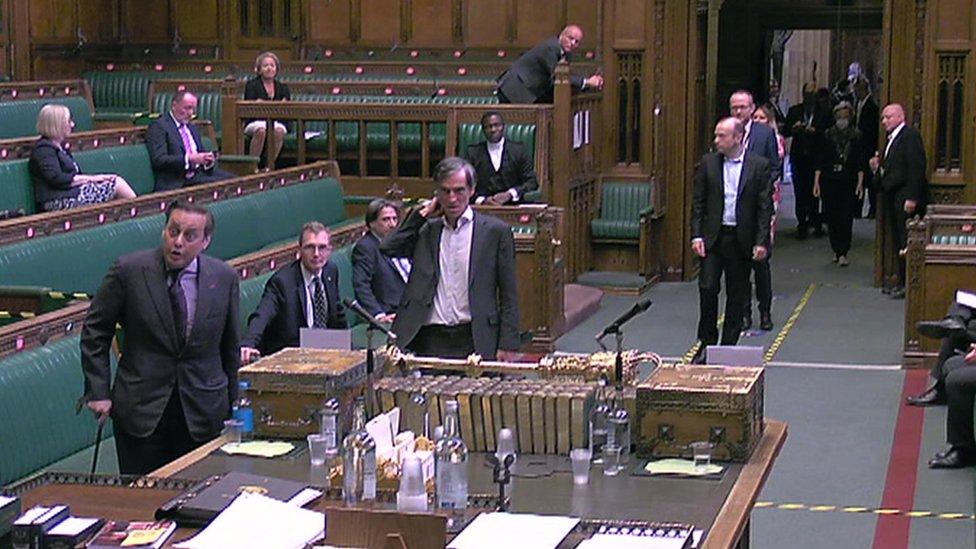The 'Mogg Conga'
- Published

MPs lining up to vote
Comedy gold…. In theory, what one MP called the "Mogg Conga," the Commons new socially distanced method of voting is perfectly simple.
A queue of honourable members snaked around the Palace of Westminster, back as far as the parliamentary offices at Portcullis House (quite a long way!) and slowly filed into their Chamber, marching left of the Mace, external to vote "Aye" and right of the Mace to vote "No" and should produce a steady flow of votes - simple in theory, but the practice was a bit messier.
They were voting to accept ("Aye") or reject ("No") a proposal to allow MPs to continue to vote remotely, during the pandemic.
Some MPs had to do a kind of mid-air double take, to double-check that they were voting the way they were supposed to.
The DUP's Jim Shannon actually went the wrong way, before correcting himself, and senior Tory Tim Loughton appeared to make a last minute decision, and changed course to vote Aye.
David Rutley voted No for himself but also registered a proxy vote Aye on behalf of Nigel Mills.
Sometimes they forgot to announce their names, sometimes they forgot to say Aye or No… the Speaker had to urge them on, when the pace faltered, and he even rebuked the SNP's Gavin Newlands, who turned up to vote in denim shorts - scandalous!
Labour's Lloyd Russell Moyle added "what a farce" as he voted Aye. Kevin Brennan announced he was "voting Aye in the Mogg shambles" as the Leader of the Commons - close behind - registered his No vote.
With a number of Conservatives poised to vote against the government line, this was a very public way to rebel - the first time, indeed, that MPs have ever cast their individual votes under the gaze of the cameras.
Walk this way
A whip stood by the chairs overlooking the door to the Chamber, telling Conservative MPs "name and No" as they came in.
Ministers and Cabinet Ministers strode through, obedient to the government line.
Most Conservative backbenchers did the same.
But an eclectic collection did walk the other way, with a certain straightening of the back, and the steady tone of voice required to present the proper image - they included some hardline Brexiteers (Peter Bone, John Redwood) and a selection of select committee luminaries (Karen Bradley, Geoffrey Clifton-Brown, Tom Tugendhat).
The procession finally ended with the Chief Whip, Mark Spencer, voting No and adding "all out," with audible satisfaction.
He had won - 242 Noes to 185 Ayes.
The whole exercise took 44 minutes almost three times longer than the 16 minutes for traditional method, and also significantly longer than the online voting procedure.
OK for a one-off vote, bearable for a couple of votes, but it would be very hard going for the Report Stage of a complicated bill, where there might be five or six divisions.
Then they were straight into a re-run - this time on the main Mogg motion, the government's proposed voting procedure. It seemed to run a little more smoothly this time.
